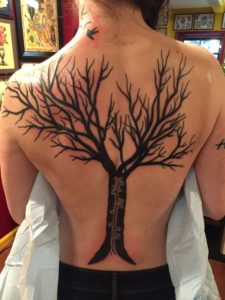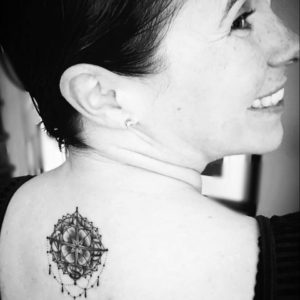 Emmie Mears’s most recent novel A Hall of Keys and No Doors
Emmie Mears’s most recent novel A Hall of Keys and No Doors is about magic keys and grief and what we can and cannot control. The book mentioned in this interview, Look to the Sun
is about magic keys and grief and what we can and cannot control. The book mentioned in this interview, Look to the Sun , is about the subtle magic of stories we tell ourselves and the stories we tell others. It comes out 15 November and is available for preorder now. Here’s what they say about this amazing tree:
, is about the subtle magic of stories we tell ourselves and the stories we tell others. It comes out 15 November and is available for preorder now. Here’s what they say about this amazing tree:
I spent a decade wanting tattoos before I got any, and then my first one was a whim.
When I got married the first time, I picked out a ring that had deep meaning for me: a white gold band with ogham writing that said “my love on you” in Gaelic. That ring held no meaning for my husband–he never got my desire to move back to Scotland or how much that place felt like home for me. The day our divorce finalised, I decided in the car on the way home and got those ogham words tattooed on my arm.
A couple months later, I got started on the big piece, the back piece. From my lumbar region to just below my ear, I have a tree that stretches asymmetrically up my back. At the top is a trio of crows in flight, in silhouette. Down the trunk is more ogham, this bit reading “remember where you came from.”
***
I can still remember the smell of Simple Green, and it still makes me want to urp.
For most of my childhood, my family was so poor that we inhabited tiny log cabins with little to no plumbing. I shared a room with my mother that we rented from a woman in Portland. Later, I lived for months at a time in a tent on a patch of land. After that, in an actual barn we tried to make into a cabin. Most of those places had no functioning toilet. When I tell people that I grew up without a toilet, I get a lot of strange looks.
We used to dump Simple Green into the five gallon bucket we used as “the pot”.
It was my job to empty it.
***
Both my biological parents have had troubled lives. I’ve collected parental figures along the way, from my mother’s long term partner who I still see as my second mum to my step-dad, to a woman called Donna who took me under her wing in our church before cancer killed her, to families that gave me a place to stay when I could not stay at home (or when home got taken out from under us).
For this among many reasons, any desire I had to have children fell away from me in my early twenties. I’ve taken care of myself since I was thirteen. I staged my exit from home beginning at sixteen. At thirty-one, I have a healthy, loving relationship. A flushing toilet. (Booyah!) Two kitties.
My partner and I are about to move to Scotland.
***
In my forthcoming novel,
Look to the Sun
, I found myself heavily identifying with Beo, one of the POV characters. His tattoo covers his forearm and is the first major connection between Beo and Rose, the other POV character and part of the poly romance in the book.
Like me, Beo has survived abusive relationships. Like me, he decided he wanted to wear his stories in his skin.
Tattoos are intensely personal things most of the time. They’re with us foreverish. But no matter how obscure they seem to be, they communicate part of our inner lives with the outside world. Just like Rose recognises the design of Beo’s tattoo as being from her all-time favourite book, I have people recognise the ogham writing on my arm or ask me about the vein-like branches that cover my shoulder.
Tattoos are just another way of telling stories.
***
A year from now, my partner and I will (dog willing) be ensconced in a Glasgow flat, having done something I’ve been trying to do for thirteen years.
***
I sometimes forget that my back is covered in ink.
Two of my great aunts, on opposite sides of my family, have spent decades combing through genealogical records about our family. On both sides, there is a lot of strong oral tradition and a lot of familial history that has been passed down for generations. Much of it eludes what documentation any of us have been able to find.
My family on both sides is insistent that we came from Scotland, from Wales. Sometimes by way of Ireland (this much is documented), sometimes appearing with a wave of other immigrants after a significant historical event (like Culloden) (this is fuzzier).
I had my DNA run through the system at Ancestry.com. After 40+ moves on American soil and a tendency to splutter when someone asks me where I’m from, that question spurs a small internal tornado: do I say Texas, where I was born but spent less than three months? Arkansas? Alaska, where I was a toddler? Oregon maybe? Montana, where I graduated high school? Maryland, where I’ve technically spent the most time? I still never know. Sometimes I catch a glimpse of myself in the mirror and see the branches there and only then remember that tattoo.
Before this last year, I was happiest in Poland. But Poland would not welcome my queer, trans self now. My happiness when I lived in Scotland was more transitive itself. I never had a flat there, just a bunk bed and a room full of loved ones who ate and slept and traveled and learned together.
But of all the places I’ve lived, Scotland was always home. I don’t know if it is where I came from. That DNA test said my DNA is Scandinavian. Which, hey. I mean, the Vikings got around. My aunts have traced our family back centuries and there’s not a Swedish, Norwegian, or Danish name to be found among the Welsh and Scottish and English and German ones. It doesn’t really matter–Scotland is a welcoming place for those who seek to make their homes there.
Which brings that second tattoo back to the first one: my love on you. And, more ephemerally, to the second tattoo’s deeper meaning.
I got that first armband on a whim, but I got it because I needed the meaning. It was important for me to affirm that to myself, that I deserve self-love. I stayed in my marriage longer than I ought to have done because I forgot that I could love myself.
As for the other, “remember where you came from”, it’s less about geography and more about self. It is the germinating seed that grows our tree. The branches we reach upward and the roots we sink into soil. We came from stars and live by the light of one. What a miraculous thing.
These first two tattoos cover a lot of me, but I’ve got a lot of canvas left to explore.
About this post: Inksplanations (and variations thereon) is the name for a series of short interviews where I ask genre writers about their tattoos. Why they got them, what they mean, how getting ink did or didn’t change them–any and all of these topics are fair game. What drives a literary artist to literally become canvas for an image or epigram? Did they get what they were seeking? I wanted to know, especially after I got my 2016 poppies from Toronto artist Lorena Lorenzo at Blackline Studio, and so I did what any curious writer would do. I asked!
Next week we’ll have Fran Wilde, answering the same question.
 Fran Wilde is the author of the Andre Norton and Compton Crook Award-winning and Nebula-nominated novel Updraft
Fran Wilde is the author of the Andre Norton and Compton Crook Award-winning and Nebula-nominated novel Updraft



 Happy Halloween, everyone!!
Happy Halloween, everyone!!


 With Halloween coming up any minute now, I thought I should reshare my Tor.com review of one of the scariest books I’ve read in recent years, Christopher Buehlman’s
With Halloween coming up any minute now, I thought I should reshare my Tor.com review of one of the scariest books I’ve read in recent years, Christopher Buehlman’s 
 Emmie Mears’s most recent novel
Emmie Mears’s most recent novel 
